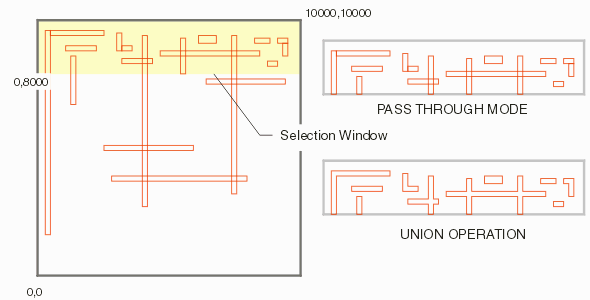Pass Through Mode

boolw32f includes a "pass through mode" which can quickly extract data that crosses (or is contained by) a selection window. Pass through mode does not unionize or otherwise process the polygons that are completely within the selection window -- however any polygons that cross the selection window are clipped to the window's border. Of course the output file is still flattened and has no hierarchy.
Q. Why Use Pass Through mode?
A. Speed and memory usage. Often one must deal with really enormous GDSII files which load, display and can be manipulated very slowly. If the nature of your problem is such that the job can be broken down into smaller regions then using boolw32f to create these windows in pass through mode can be very efficient.

Q. What is the correct boolw32f syntax to do this?
boolw32f input.gds output.gds TOP 5 p5 -window:0,8000,10000,10000
where
input.gds input gdsii stream file
output.gds results file
TOP structure name of input file
5 output layers to create
p5 input layer. "p" indicates passthrough mode
-window:x1,y1,x2,y2 selection window defined by corners x1,y1 and x2,y2
you do not need and should not use the -union
or the +nclip:1,1 command line options
Q. What is the correct boolw32f syntax to process all layers?
boolw32f input.gds output.gds = = p -window:0,8000,10000,10000
where
input.gds input gdsii stream file
output.gds results file
= structure name of input file
= process all layers
p "p" indicates passthrough mode
-window:x1,y1,x2,y2 selection window defined by corners x1,y1 and x2,y2
you do not need and should not use the -union
or the +nclip:1,1 command line options